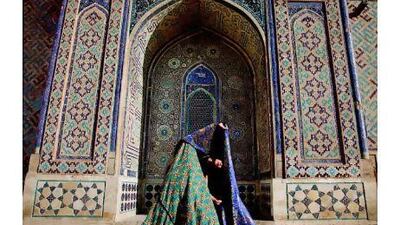Can one artwork sum up a whole art fair? Probably not. But it can give the event its ominous, incidental soundtrack.
The sixth edition of Art Dubai stormed through the weekend in a flurry of parties, conversations, sales reports and two men dressed like penguins hollering into microphones: "Do you feel this?" (WolfPakistan, performing on Thursday).
Yet meanwhile, sited on the banks of the host venue, Madinat Jumeirah's faux-canals, a shanty-version of a traditional windtower offered the fair a background marching beat.
The Turkish artist Deniz Uster's wooden windtower, created during her three-month residency in Dubai, contained a model of an oil derrick rising from a graveyard of toy cars. On top of the derrick, a squeaky mechanism turned, causing a rubber mallet to make a steady rhythm on a drum suspended above.
This constant beat seemed to lead the footfall of Art Dubai's estimated 22,000 visitors, who came through the halls of the Madinat in a parade of swinging tote bags. Couple this with 75 groups flying in from museums internationally and the much-expanded line-up of speakers on the Global Art Forum, and this year's fair has felt like a well-oiled machine.
Amid the booths, men swathed from head to toe in tissue paper clambered, Neanderthal-like, around glaciers of broken glass. "What are they doing, mummy?" asked a small girl, looking at this performance piece orchestrated by the Lebanese artist Marya Kazoun. "I don't know, dear," was the mother's bemused answer.
Elsewhere, gallerists politely dissuaded the public from getting too touchy with the artwork and visitors had to dodge a beatifically smiling Chinese collector who wandered the halls with an iPad held aloft to record his journey.
On the booth of New York's Leila Heller Gallery, the canvases of Shiva Ahmadi grabbed and enthralled. Ahmadi's paintings offer a violent circus of modernity meeting tradition, in which the faces of anonymous figures cascade with oozing red and animal-human hybrids prance around them.
Incredible works in charcoal from the studio of William Kentridge, arguably South Africa's most celebrated contemporary artist, were another highlight. Kentridge is known for arduously hand-drawn animations about the tumult of South Africa's recent history. A new animated work, created to spark the memory of his ageing, increasingly frail mother was on the booth of SA's Goodman Gallery.
The MARKER section of the fair is devoted to lesser-known territories of art, and focused on Indonesia this year. Curated by Alia Swastika, the co-curator of the Yogyakarta Biennale in 2011, the quality of work brought by these six galleries was rather mixed but did show off a penchant for art in new and more experimental mediums in the world's largest Muslim country.
"We've found that the collectors in the Gulf are into contemporary ideas and approaches in artwork but more drawn to traditional mediums of expression," said Esti Nurjadin of Jakarta's d Gallerie.
A mini media storm erupted after works by two artists were removed from the booth of Artspace, a gallery based in Dubai International Finance Centre, after concerns by security officers that they could be deemed offensive. One of the paintings, Shadi Alzaqzouq's After Washing, depicts a masked female protester holding up a pair of men's briefs, emblazoned with the word "leave" in Arabic - an organising chant heard in protests in Tahrir Square last year.
"I think it was more a matter of decency than anything political," said Sossy Dikijian, the gallery's co-director. Two other Dubai-based galleries were told to remove works from their booths by security officers.
It's interesting to note here that the Financial Times' art market correspondent Georgina Adam, speaking as part of the Global Art Forum's excellently paced line-up of discussions this year, told us that paintings with red in them tend to sell better, as do choppy rather than calm seas.
But the drumbeat of economy still resounded through this year's fair. The vernissage on Wednesday was markedly successful, with both incoming and home-turf galleries reporting healthy sales from the starting gun. This gave way to much more steady buying, and though interest was solid throughout, some Art Dubai stalwarts did note the increasingly apparent need for a new generation of collectors from the region.
Big sales on the opening night included an oil-on-canvas by Syed Sadquain from Pakistan, which fetched US$200,000 (Dh735,000) on the booth of Grosvenor Vadhera.
"I've been amazed at the spectrum of nationalities; we've sold work to collectors from Europe, the Gulf and Asia," said Polly Robinson Gaer, the senior director of The Pace Gallery in London, a newcomer to Art Dubai and one of the world's most notable galleries. "We are here because the Gulf is a very important market for galleries to take seriously."
This is the second year that the fair director Antonia Carver has taken the reins of Art Dubai, and increased its focus on projects additional to the fair.
"We're already building links beyond the Middle East and South Asia," she said. "But, in the future, we'd like to develop our links with Africa, and particularly East Africa, due to its historical ties with the Gulf."
As the fair evaporates and the months of press releases, build-up, shipping and organising fade into oblivion for another year, an increasing focus on year-round projects and presence beyond the March event is how Carver sees the future of Art Dubai.
It's fitting then that, amid the clean-up, Deniz's drum thuds on.

